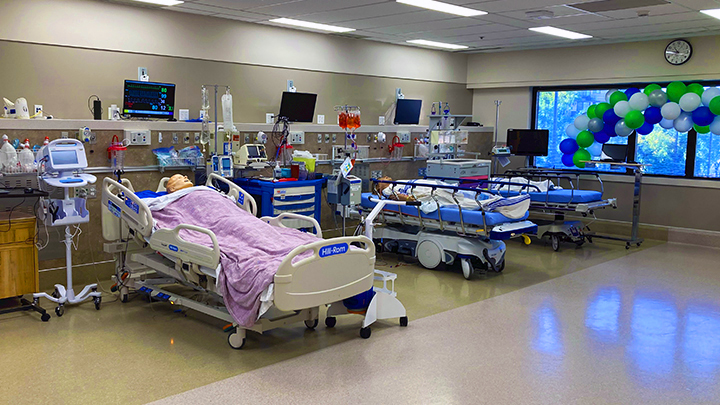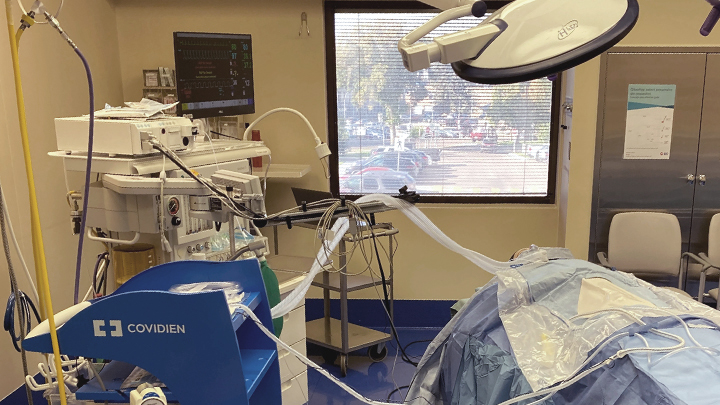
December 11, 2023

Medicine Hat Regional Hospital’s eSIM lab recreates clinical events so healthcare staff can practise critical skills in a safe, controlled environment. Photo courtesy of Jennifer Vanderlaan.

The eSIM operating room is the first of its kind in the province. Photo courtesy of Jennifer Vanderlaan.
Story & photos by Jennifer Vanderlaan
MEDICINE HAT — Southern Alberta patients benefit from the state-of-the-art simulation lab at Medicine Hat Regional Hospital (MHRH), which has helped to preserve and enhance healthcare education in the community for more than three years.
Previously a clinical area within MHRH, eSIM’s simulation lab — which is short for Educate, Simulate, Innovate, Motivate — is an educational training space in which clinical events are recreated so healthcare staff can practise critical skills in a safe, controlled environment.
“This is a state-of-the-art facility — and we’re really proud of the work that went into creating this space,” says Dr. Vincent Grant, Medical Director for the eSIM Provincial Simulation Program.
“Simulations allow individuals and teams to test their knowledge, skills, teamwork and local clinical environments, potentially identifying and correcting issues in the care process or environment before entering a real clinical space.”
In the lab, three simulated patient-care areas, a control room and a dedicated debriefing space allow instructors and staff to work through a variety of realistic scenarios as they boost their competency and confidence.
“The new lab gives us the opportunity to work with staff and teams in a safe and controlled environment, ultimately growing and improving skills and knowledge in our communities,” says Amanda Dyck, Simulation Consultant for MHRH and southeast Alberta. “This has great benefits for urban and rural healthcare.”
The lab also boasts an OR simulation lab — the first of its kind in the province.
“The dedicated OR space allows us to ensure we’re training as many staff as needed without interrupting the day-to-day functions of an active OR,” says, Randi Galenzoski, a Clinical Nurse Educator who specializes in operating room and post-anesthetic care.
The lab is comes with two lifelike mannequins, from babies to adults, that can mimic human physiological responses such as breathing, heart rate and blood pressure. They even have the ability to sweat or bleed, allowing facilitators to simulate cardiac arrests, respiratory distress and other clinical situations.
“This allows staff to learn in a realistic, hands-on way,” adds Galenzoski. “Staff practise a variety of scenarios so that when they occur in real time, they can take care of their patient efficiently and effectively.”
The lab is used to orientate new staff and provide continuing education for existing staff — and facilitates interprofessional training that allows members of the healthcare team to cohesively practise communicating, collaborating, making decisions, delivering interventions and care planning.
“Teams come together and, in doing so, they learn how each other thinks, and what everyone’s priorities and responsibilities are,” says Galenzoski. “It helps us to build communication and improve the team dynamic in a safe space, which translates into better care for patients.”
After each session, teams gather in a dedicated debriefing area to review their scenario and get the kind of feedback that’s critical for team development and continuous improvement.
“The debrief is a great opportunity to sit down and talk about what worked and what could be done better next time,” says Sue Barnes, Provincial Simulation Lead, eSIM Provincial Simulation Program. “The lessons learned are an integral piece for change management, improving confidence and patient safety.”
The lab supports practice areas such as pediatrics, obstetrics, neonatal intensive care, geriatrics, emergency, trauma, EMS, the operating room (OR) and post-anesthetic care, medical units, surgical units, mental health, rural, and intensive care.
The program casts a wide net, as evidenced by the 190 simulation sessions booked across the South Zone in 2022-2023. During this time, 1,540 people participated more than 1,092 hours of simulation at 14 sites.
Recently, to mark three years of successful operation, the lab opened its doors for physicians, staff and partners to gather for an official ribbon-cutting.
“I’d like to thank the Medicine Hat District Health Foundation for funding the project, and to AHS’ Facilities, Maintenance and Engineering and the many staff and community members who stepped up to help this project along,” says Dr. Grant.